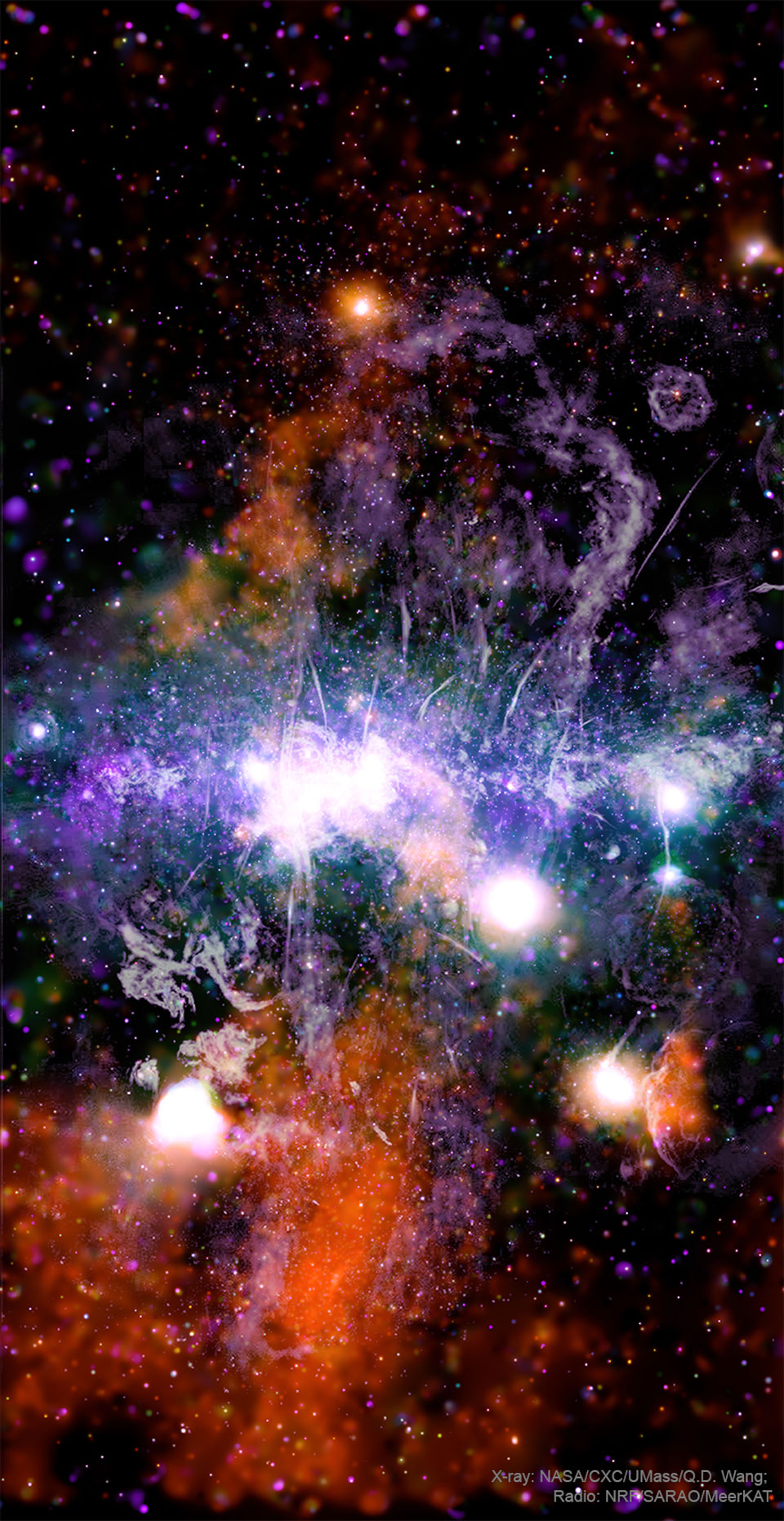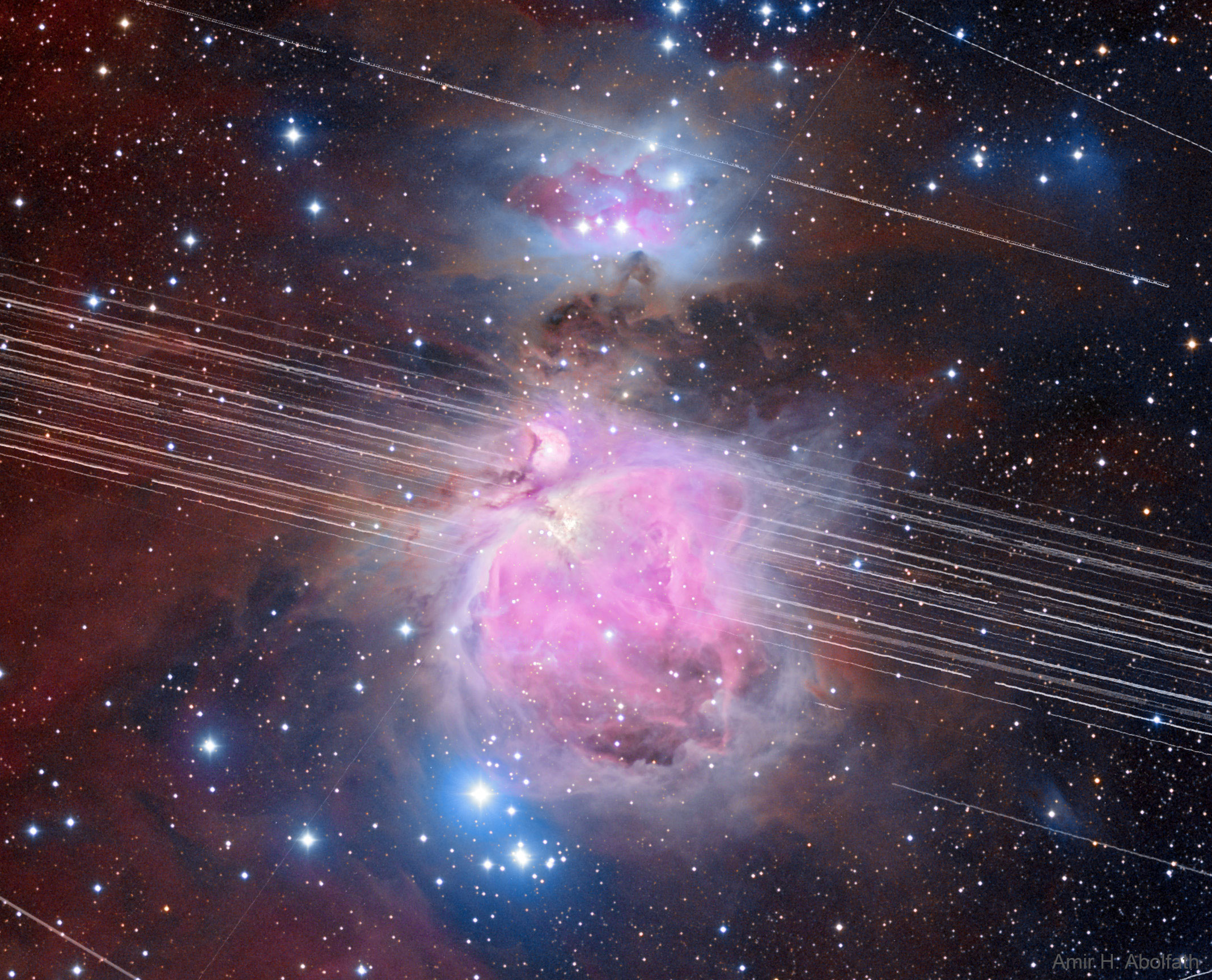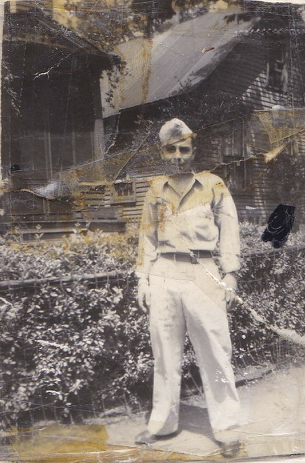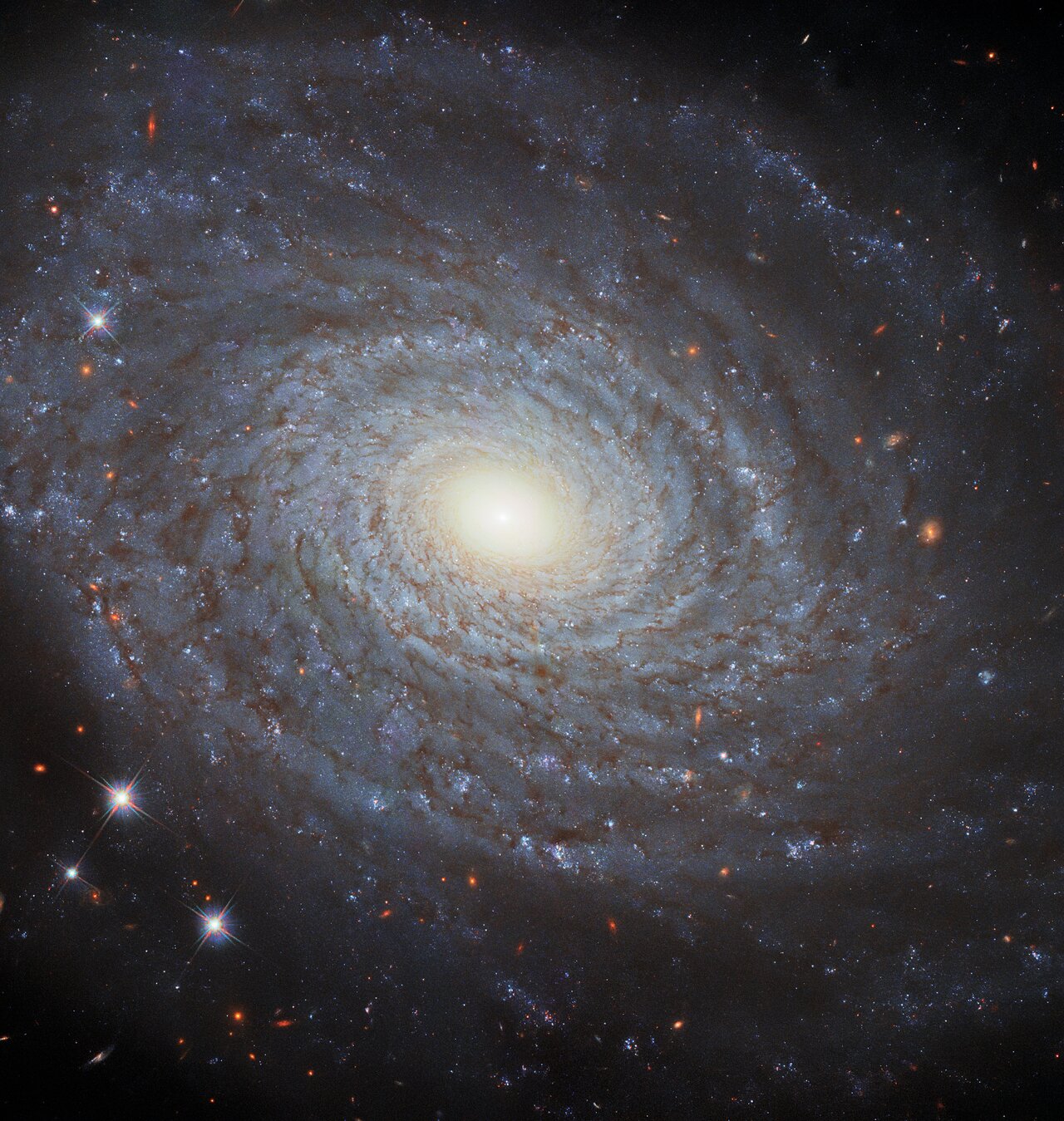Blog
A newly detailed panorama has been composed that explores regions just above and below the galactic plane in radio and X-ray light. X-ray light taken by the orbiting Chandra Observatory is shown in orange (hot), green (hotter), and purple (hottest) and superposed with a highly detailed image in radio waves, shown in gray, acquired by the MeerKAT array. Interactions are numerous and complex. Galactic beasts such as expanding supernova remnants, hot winds from newly formed stars, unusually strong and colliding magnetic fields, and a central supermassive black hole are all battling in a space only 1000 light years across. Thin bright stripes appear to result from twisting and newly connecting magnetic fields in colliding regions, creating an energetic type of inner galactic space weather with similarities to that created by our Sun. Continued observations and study hold promise to not only shed more light on the history and evolution of our own galaxy — but all galaxies.

more...
Charles Robert Watts (born 2 June 1941) is an English drummer, best known as a member of the Rolling Stones since 1963. Originally trained as a graphic artist, he started playing drums in London’s rhythm and blues clubs, where he met Brian Jones, Mick Jagger, and Keith Richards. In January 1963, he joined their fledgling group, the Rolling Stones, as drummer, while doubling as designer of their record sleeves and tour stages. Watts has been the only Rolling Stones member other than Jagger or Richards to have been featured on all of their studio albums. He cites jazz as a major influence on his drumming style. He has toured with his own group, the Charlie Watts Quintet, and appeared in London at Ronnie Scott’s Jazz Clubwith the Charlie Watts Tentet.
In 2006, Watts was elected into the Modern Drummer Hall of Fame; in the same year, Vanity Fair elected him into the International Best Dressed List Hall of Fame. In the estimation of noted music critic Robert Christgau, Watts is “rock’s greatest drummer.” In 2016, he was ranked 12th on Rolling Stone‘s “100 Greatest Drummers of All Time” list.
https://www.youtube.com/watch?v=4b8w44FEjk4
more...Hermenengildo “Gildo” Mahones (June 2, 1929, New York City – April 27, 2018) was an American jazz pianist.
Mahones was born to Puerto Rican parents in East Harlem in New York City. Early in his career, he played with Joe Morris (1948) and Milt Jackson. Mahones served in the Army, and then played with Lester Young from 1953 to 1956. Later in the 1950s Mahones toured with the Jazz Modes (which included Charlie Rouse and Julius Watkins), Sonny Stitt, and Benny Green. From 1959 to 1964 Mahones played behind Lambert, Hendricks & Ross.
When Lambert, Hendricks & Ross broke up, Mahones moved to Los Angeles, where he worked both as a studio musician and as a jazz sideman. He led his own trio and appeared on recordings by O. C. Smith, Lou Rawls, James Moody, Harold Land and Blue Mitchell, Leon Thomas, Jim Hall, Big Joe Turner, Lorez Alexandria, Benny Carter, Pony Poindexter, Booker Ervin, and Jimmy Witherspoon.
Mahones died on April 27, 2018, aged 88.
more...Valaida Snow (June 2, 1904 – May 30, 1956) was a virtuoso American jazz musician and entertainer who became an internationally celebrated talent. She was known as “Little Louis” and “Queen of the Trumpet,” a nickname given to her by W.C. Handy.
Snow was born in Chattanooga, Tennessee. Her mother, Etta, was a Howard University-educated music teacher and her father, John, was a minister who was the leader of the Pickaninny Troubadours, a group mainly consisting of child performers. Raised on the road in a show-business family, where starting from the age of 5, she began performing with her father’s group. By the time she was 15, she learned to play cello, bass, banjo, violin, mandolin, harp, accordion, clarinet, trumpet, and saxophone. She also sang and danced. Her solo career began when she joined a popular revue called “Holiday in Dixieland,” after exiting an abusive marriage. She then held a residency at a Harlem cabaret, which helped lead her to be cast along Josephine Baker in the musical “In Bamville,” a follow-up to the enduring hit musical “Shuffle Along.” While the musical was itself not a hit, Baker and Snow both received positive reviews.
According to a jazz radio show that aired October 28, 2017, she said she was arrested in Europe, apparently going to jail for theft and illegal drugs. While later touring through Denmark in 1941, she said she was arrested by Nazis and probably kept at Vestre Fængsel, a Danish prison in Copenhagen that was run by the Nazis, before being released on a prisoner exchange in May 1942. It was rumored that her friendship with a Belgian police official helped her to board a ship carrying foreign diplomats. According to jazz historian Scott Yanow, “she never emotionally recovered from the experience”. She married Earl Edwards. In the 1950s, she was unable to regain her former success.
Valaida Snow died of a brain hemorrhage on May 30, 1956, in New York City, backstage during a performance at the Palace Theater.
https://www.youtube.com/watch?v=W5DZhcaYVyE
more...Sir Edward William Elgar, 1st Baronet, OM, GCVO (/ˈɛlɡɑːr/ (![]() listen);[1] 2 June 1857 – 23 February 1934) was an English composer, many of whose works have entered the British and international classical concert repertoire. Among his best-known compositions are orchestral works including the Enigma Variations, the Pomp and Circumstance Marches, concertos for violin and cello, and two symphonies. He also composed choral works, including The Dream of Gerontius, chamber music and songs. He was appointed Master of the King’s Musick in 1924.
listen);[1] 2 June 1857 – 23 February 1934) was an English composer, many of whose works have entered the British and international classical concert repertoire. Among his best-known compositions are orchestral works including the Enigma Variations, the Pomp and Circumstance Marches, concertos for violin and cello, and two symphonies. He also composed choral works, including The Dream of Gerontius, chamber music and songs. He was appointed Master of the King’s Musick in 1924.
Although Elgar is often regarded as a typically English composer, most of his musical influences were not from England but from continental Europe. He felt himself to be an outsider, not only musically, but socially. In musical circles dominated by academics, he was a self-taught composer; in Protestant Britain, his Roman Catholicism was regarded with suspicion in some quarters; and in the class-conscious society of Victorian and Edwardian Britain, he was acutely sensitive about his humble origins even after he achieved recognition. He nevertheless married the daughter of a senior British Army officer. She inspired him both musically and socially, but he struggled to achieve success until his forties, when after a series of moderately successful works his Enigma Variations (1899) became immediately popular in Britain and overseas. He followed the Variations with a choral work, The Dream of Gerontius (1900), based on a Roman Catholic text that caused some disquiet in the Anglicanestablishment in Britain, but it became, and has remained, a core repertory work in Britain and elsewhere. His later full-length religious choral works were well received but have not entered the regular repertory.
In his fifties, Elgar composed a symphony and a violin concerto that were immensely successful. His second symphony and his cello concerto did not gain immediate public popularity and took many years to achieve a regular place in the concert repertory of British orchestras. Elgar’s music came, in his later years, to be seen as appealing chiefly to British audiences. His stock remained low for a generation after his death. It began to revive significantly in the 1960s, helped by new recordings of his works. Some of his works have, in recent years, been taken up again internationally, but the music continues to be played more in Britain than elsewhere.
Elgar has been described as the first composer to take the gramophone seriously. Between 1914 and 1925, he conducted a series of acoustic recordings of his works. The introduction of the moving-coil microphone in 1923 made far more accurate sound reproduction possible, and Elgar made new recordings of most of his major orchestral works and excerpts from The Dream of Gerontius.
more...What are those streaks across Orion? They are reflections of sunlight from numerous Earth-orbiting satellites. Appearing by eye as a series of successive points floating across a twilight sky, the increasing number of communications satellites, including SpaceX Starlink satellites, are causing concern among many astronomers. On the positive side, Starlink and similar constellations make the post-sunset sky more dynamic, satellite-based global communications faster, and help provide digital services to currently underserved rural areas. On the negative side, though, these low Earth-orbit satellites make some deep astronomical imaging programs more difficult, in particular observing programs that need images taken just after sunset and just before dawn. Planned future satellite arrays that function in higher orbits may impact investigations of the deep universe planned for large ground-based telescopes at any time during the night. The streaks across Orion are not from Starlink but rather satellites in high geosynchronous orbit. The featured picture, taken in 2019 December, is a digital combination of over 65 3-minutes exposures, with some images taken to highlight the background Orion Nebula, while others to feature the passing satellites.

more...
Ronald David Wood (born 1 June 1947) is an English rock musician, songwriter, multi-instrumentalist, artist, author, and radio personality best known as a member of The Rolling Stones since 1975, as well as a member of Faces and the Jeff Beck Group.
Wood began his career in 1964, when he joined The Birds (not to be confused with the American band The Byrds) on guitar. He then joined the modgroup The Creation, but remained with the group only for a short time and appeared on only a few of their singles. He joined the Jeff Beck Group in 1967 as a bass player. Their two albums, Truth and Beck-Ola, are both highly praised.
The group split in 1969 and Wood departed along with lead vocalist Rod Stewart to join former Small Faces members Ronnie Lane, Ian McLagan, and Kenney Jones in a new group named Faces. The group found great success in the UK and mainland Europe, though achieved only cult status in the US. Wood sang and co-wrote the popular title track from their final LP, Ooh La La, released in 1973.
As the group began to split he began several solo projects, eventually recording his first solo LP, I’ve Got My Own Album to Do, in 1974. The album featured bandmate McLagan as well as former Beatle George Harrison and Keith Richards of the Rolling Stones, a longtime friend of Wood. After the departure of Mick Taylor from The Stones, Richards soon invited Wood to join them; he did so in 1975, but was not officially inducted as a member until bassist Bill Wyman‘s departure in 1993.
Besides I’ve Got My Own Album to Do, Wood has recorded several other solo efforts. Now Look was released in 1975, and peaked at No. 118 on Billboard; he also collaborated with Ronnie Lane for the soundtrack album Mahoney’s Last Stand. Wood also released Gimme Some Neck in 1979, which hit No. 45 in the US; 1234 was released in 1981, peaking at No. 164. He released Slide on This in 1992, Not for Beginners came out in 2002.and I Feel Like Playing in 2010. As a member of The Rolling Stones, Wood was inducted into the Rock and Roll Hall of Fame in 1989, and was inducted a second time, as a member of Faces, in April 2012.
more...Herbie Lovelle (1 June 1924 – April 8, 2009) was an American drummer, who played jazz, R&B, rock, and folk. He was also a studio musician and an actor.
Lovelle’s uncle was the drummer Arthur Herbert. Lovelle began his career with the trumpeter, singer and band leader Hot Lips Page in the late 1940s, then played in the 1950s with the saxophonist Hal Singer, Johnny Moore‘s Three Blazers and the pianist Earl Hines. Through working for both Lucky Thompson and Jimmy Rushing of Count Basie’s Orchestra, he became house drummer at the Savoy Ballroom in New York City for much of the 1950s. He toured with the tenor saxophonist Arnett Cobb and the pianist Teddy Wilson in 1954. In 1959 he contributed to the pianist Paul Curry’s album Paul Curry Presents the Friends of Fats, released on the Golden Crest label.
In the early years of television, he performed with the King Guion Orchestra on the Jerry Lester Show and the Ed Sullivan Show. In 1966, he was the lead drummer for the Sammy Davis, Jr. TV show.
Lovelle began playing more R&B in the 1950s and worked as a studio musician, often with Sam Taylor. He played on albums by Bob Dylan (The Freewheelin’ Bob Dylan), Pearls Before Swine, Eric Andersen, David Blue, John Denver, Tom Rush, B. B. King, John Martyn (Stormbringer!), the Strangeloves, the McCoys, and the Monkees. He continued working as a studio musician well into the 1980s.
more...Nelson Smock Riddle Jr. (June 1, 1921 – October 6, 1985) was an American arranger, composer, bandleader and orchestrator whose career stretched from the late 1940s to the mid-1980s. He worked with many world-famous vocalists at Capitol Records, including Frank Sinatra, Ella Fitzgerald, Nat King Cole, Judy Garland, Dean Martin, Peggy Lee, Johnny Mathis, Rosemary Clooney and Keely Smith. He scored and arranged music for many films and television shows, earning an Academy Award and three Grammy Awards. He found commercial and critical success with a new generation in the 1980s, in a trio of Platinum albums with Linda Ronstadt.
Riddle was born in Oradell, New Jersey, the only child of Marie Albertine Riddle and Nelson Smock Riddle, and later moved to nearby Ridgewood. Following his father’s interest in music, he began taking piano lessons at age eight and trombone lessons at age fourteen. He was encouraged to continue his musical pursuits at Ridgewood High School. In 1950, Riddle was hired by composer Les Baxter to write arrangements for a recording session with Nat King Cole; this was one of Riddle’s first associations with Capitol Records. Although one of the songs Riddle had arranged, “Mona Lisa,” soon became the biggest selling single of Cole’s career, the work was credited to Baxter. However, once Cole learned the identity of the arrangement’s creator, he sought out Riddle’s work for other sessions, and thus began a fruitful partnership that furthered the careers of both men at Capitol.
more...Lafayette Leake (June 1, 1919 – August 14, 1990) was an American blues and jazz pianist, organist, vocalist and composer who played for Chess Recordsas a session musician, and as a member of the Big Three Trio, during the formative years of Chicago blues. He played piano on many of Chuck Berry‘s recordings.
Leake was born in Winona, Missouri, United States, in 1919. Information about his early years is sparse, but in the early 1950s he joined the Big Three Trio (replacing Leonard Caston) and began his association with Chess Records, where he worked closely with bassist, producer, and songwriter Willie Dixon.
Leake played piano on One Dozen Berrys, Chuck Berry’s second album, released in 1958 by Chess. He was then on Chuck Berry Is on Top; Leake (not Berry’s longtime bandmate Johnnie Johnson) played the prominent piano on the classic original rendition of “Johnny B. Goode“, as well as “Rock and Roll Music“. Leake played on numerous other Chess sessions from the 1950s through the 1970s, backing many Chess musicians, including Sonny Boy Williamson, Otis Rush, Junior Wells, and Little Walter. Leake gave Chicago blues musician Harmonica Hinds his first harmonica lesson on the street in Toronto, Ontario.
more...Honoring my dad Mike Labriola who served our country in WWII stationed back in his homeland Italy.

This image features the spiral galaxy NGC 691, imaged in fantastic detail by Hubble’s Wide Field Camera 3 (WFC3). This galaxy is the eponymous member of the NGC 691 galaxy group, a group of gravitationally bound galaxies that lie about 120 million light-years from Earth. Objects such as NGC 691 are observed by Hubble using a range of filters. Each filter only allows certain wavelengths of light to reach Hubble’s WFC3. The images collected using different filters are then coloured by specialised visual artists who can make informed choices about which colour best corresponds to which filter. By combining the coloured images from individual filters, a full-colour image of the astronomical object can be recreated. In this way, we can get remarkably good insight into the nature and appearance of these objects.

John Henry Bonham (31 May 1948 – 25 September 1980) was an English musician and songwriter, best known as the drummer for the English rock band Led Zeppelin. Esteemed for his speed, power, fast single-footed kick drumming, distinctive sound, and feel for the groove, he is regarded as one of the greatest and most influential rock drummers in history.
Bonham was born in 1948 in Redditch, Worcestershire, and took up drums at the age of five, receiving a snare drum at the age of 10 and a full drum set at the age of 15. He played with multiple local bands both at school and following school, eventually playing in two different bands with Robert Plant. Following the demise of the Yardbirds in 1968, Bonham joined Plant, guitarist Jimmy Page and bassist John Paul Jones to form Led Zeppelin. With the band, Bonham mostly showcased a hard-hitting hard rock style, but also handled funk and Latin-influenced grooves in later releases. Like Keith Moon of the Who, Bonham’s drum set grew in size following the band’s 1969 concert tours, including congas or timpani and a gong. His drum solo, “Moby Dick“, was featured on the group’s second album and was a staple of their concerts, often lasting over 20 minutes. Outside of Led Zeppelin, Bonham played drums for other artists, including the Family Dogg, Screaming Lord Sutch, Lulu, Jimmy Stevens and Wings. Bonham played with Led Zeppelin until his death at the age of 32, in September 1980 following a day of heavy drinking. The surviving members disbanded the group out of respect for Bonham after his death.
A mostly self-taught drummer, Bonham’s influences included Max Roach, Gene Krupa and Buddy Rich. Bonham was also close with Vanilla Fudgedrummer Carmine Appice, who introduced him to Ludwig drums. While primarily known for his hard rock style during his lifetime, Bonham’s reputation as a drummer has grown beyond hard rock following his death; he is now seen as one of the greatest drummers of all time. He has influenced numerous drummers, including Dave Grohl, Chad Smith, Dave Lombardo and Mike Portnoy. He was posthumously inducted into the Rock and Roll Hall of Fame in 1995 as a member of Led Zeppelin. In 2016, Rolling Stone ranked him first in its list of the “100 Greatest Drummers of All Time”.
more...Louis Hayes (born May 31, 1937) is an American jazz drummer and band leader. He was with McCoy Tyner‘s trio for more than three years. Since 1989 he has led his own band, and together with Vincent Herring formed the Cannonball Legacy Band.
Louis Sedell Hayes was born to a father, an automaker, who played drums and piano.His mother waited tables and played the piano. Hayes got his first drum set at age 10. The key influence in his early development was his cousin Clarence Stamps, an accomplished drummer who grounded his technical fundamentals and gave him lessons that stuck for life. He refers to the early influence of hearing jazz, especially big bands on the radio. His main influence was Philly Joe Jones[2] and he was mentored by Jo Jones. His three main associations were with Horace Silver‘s Quintet (1956–59), the Cannonball Adderley Quintet (1959–65), and the Oscar Peterson Trio (1965–67). Hayes often joined Sam Jones, both with Adderley and Peterson, and in freelance settings.
When he was a teenager, he led a band in Detroit clubs before he was 16. He worked with Yusef Lateef and Curtis Fuller from 1955 to 1956. He moved to New York in August 1956 to replace Art Taylor in the Horace Silver Quintet and in 1959 joined the Cannonball Adderley Quintet, with which he remained until mid-1965, when he succeeded Ed Thigpen in the Oscar Peterson Trio. He left Peterson in 1967, and formed a series of groups, which he led alone or with others; among his sidemen were Freddie Hubbard, Joe Henderson, Kenny Barron, and James Spaulding. He returned to Peterson in 1971.
https://www.youtube.com/watch?v=hZD0YRMZMws
more...More Posts
- Flamenco Fridays Moraine Chico
- Daily Roots Earl Sixteen
- Cosmos NGC 7000
- Michael Shrieve
- Louie Bellson
- World Music Les Abranis
- Daily Roots Prince Alla
- Cosmos NGC 6188
- Arthur Blythe
- Inayat Khan
- World Music Damir Imamović
- Daily Roots Eddie Constantine
- Happy July 4th 2023
- Cosmos Aurora Waterfall
- Fred Wesley
- Bill Withers
- World Music Tony Rice
- Daily Roots The Revolutionaries
- CHORUS LINE with Theatre 55
- Cosmos UGC 11860